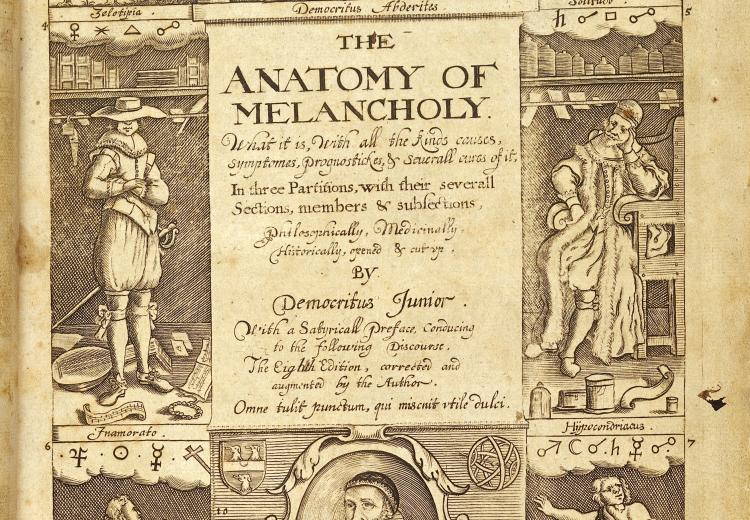Science, Shakespeare, and the STEM Humanities

Robert Burton, Anatomy of Melancholy, 1628.
"Both the sciences and the humanities require deep creativity and intellectualism, an ability and desire to use reason, and a willingness to change your mind."
—Kira Hamman, professor of mathematics, Pennsylvania State University, Mont Alto
Education and policy communities are engaged in a dynamic debate about the significance of STEM (science, technology, engineering, and mathematics) and humanities curricula that is often framed as an either/or dichotomy—STEM or humanities. But, as mathematics professor Kira Hamman recently argued in “Why STEM Should Care about the Humanities” in The Chronicle of Higher Education, STEM and humanities education are integral to living a life of meaning.
At the U.S. National Library of Medicine (part of the National Institutes of Health), the Exhibition Program embraces the and/both approach with meaningful education content designed to bridge the divide between the art and science of medicine. Its K–12 lesson plans and online activities (as well its higher education modules) carefully guide students’ discovery of how scientific endeavors are shaped by and influence society and culture. Patricia Tuohy, Head, Exhibition Program, History of Medicine Division, National Library of Medicine, with Exhibition Program educator, Jiwon Kim, architect of the National Library of Medicine Exhibition Program online education resources, who defined STEM/Humanities for this article.
“And there’s the humor of it”: Shakespeare and the Four Humors
The Melancholy Dane, as well as a middle-school lesson (The Four Humors from Hippocrates to Shakespeare), was inspired by and is shaped around resources from a recent exhibition that looks at the medical understanding of Elizabethan England: “And there’s the humor of it”: Shakespeare and the Four Humors, co-curated by Gail Kern Paster, an accomplished Shakespearean scholar and former director of the Folger Shakespeare Library in Washington, D.C., and Theodore Brown, a respected medical historian and professor at the University of Rochester. The exhibition examines the understanding people of Elizabethan England had about the body and how it worked. It argues that this awareness influenced how Shakespeare constructed his characters and how the playwright’s audiences understood his plays.
Created in conjunction with two classroom teachers, The Melancholy Dane includes a complete suite of materials: class procedures; learning outcomes; background information; vocabulary; classroom materials; evaluations; as well as extension activities, and is aligned to NCTE National Standards. All resources were prepared and packaged to be easily accessible via hyperlinked text, with handouts provided as PDFs and MSWord documents. Teachers are encouraged to consult the online exhibition (which is directly linked on the left hand column of the lesson plan page) in order to review and learn more about the theory of health and temperament that dominated Western thought from Ancient Greece to the 19th century prior to using the lesson.
Discovering “The Melancholy Dane” in the World of Shakespeare’s Humors
In the space of two class settings, students examine excerpts from one Shakespearean comedy and one tragedy in order to experience how the playwright used humoral language to shape characters and actions. They also peer through the lens of the four humors in order to learn the role those humors played in health and in determining personality.
In the first class, students use an excerpt from Shakespeare’s The Merry Wives of Windsor to consider varying definitions of “humor” in the author’s time. They examine primary sources featured in the exhibition to learn about the four humors and humoral theory, and they review dramatic structure.
In the second class, students apply their knowledge about the melancholic humor to character analysis in order to gain a deeper understanding of Hamlet as the “melancholy prince.” They identify text references to Hamlet’s melancholy traits and assess the significance of his characterization for the play as a whole. In the end, students will be able to identify the four humors and apply this knowledge in a structured analysis of Hamlet’s melancholy. They also will have experienced working with primary sources, both textual and visual.
Teachers might introduce the lesson by explaining that for thousands of years, medical thinking believed that the four bodily humors—black bile, phlegm, blood, and yellow bile—were the cause of health and illness and shaped an individual’s character. Using the pictorial chart included in the exhibition (student-specific ones accompany the lesson), the class get a global sense of how the humors determined if one was Melancholic, Phlegmatic, Sanguine, or Choleric and how the theory accounted for differences of age, gender, emotions, and disposition. The influence of the humors also changed with the seasons, times of day, and during the human life span.
Shakespeare and his contemporaries took it as fact that heat would stimulate action, and cold would depress it. For example, a young warrior’s “choler” would give him courage but “phlegm” would produce cowards. Youth would be hot and moist; age would be cold and dry. Men as a sex were hotter and drier than women. With this near universal understanding, the playwright could use the language of the four humors—language that still resonates with us today—to create characters—sanguine or melancholic, or full of bile—that would be readily recognizable to his audiences.
Last Words
All of the Exhibition Program projects at the National Library of Medicine have one thing in common—they are about people—scientists, inventors, activists, men, women, and young people—from around the world in all times.“And there’s the humor of it”: Shakespeare and the Four Humorsis about the playwright, his audiences, and how they understood medicine of their times. Understanding their histories can help us see more clearly our present and better imagine the future. Please let the Exhibition Program staff at the NLM know:
- If the multi-disciplinary STEM/humanities approach to developing meaningful lesson plans is exciting to you;
- If you are a classroom educator and have used our lesson plans—please tell them about your experiences; and/or
- If you are a classroom educator and would like to work with them.
